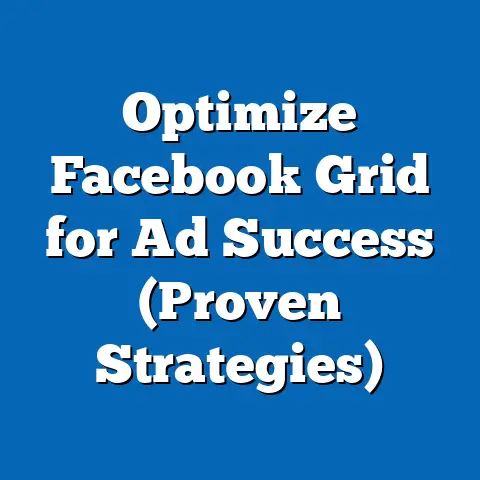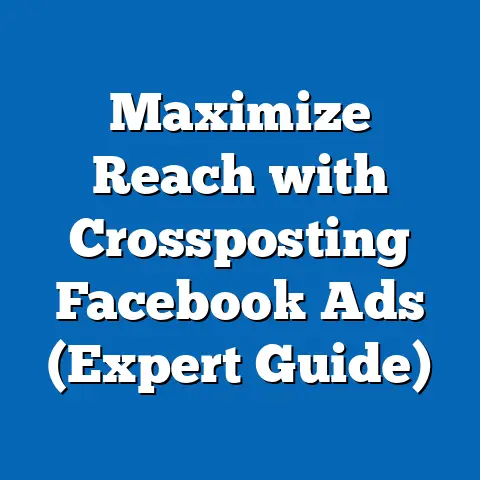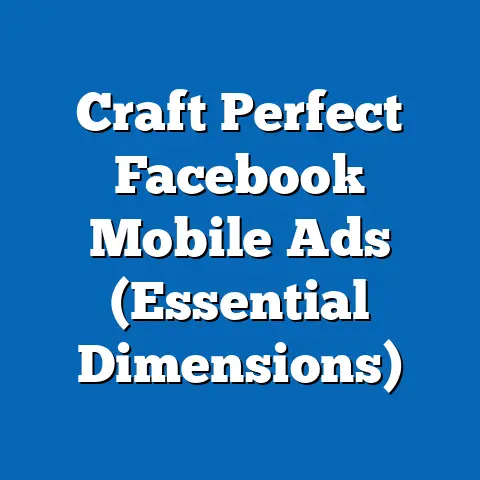Boost Financial Planning with Facebook Ads (Conversion Secrets)
The financial world is a constantly shifting landscape. What worked yesterday might not work today, and that’s especially true for financial planners. To thrive, you need to be proactive, adaptable, and always looking for new ways to connect with clients. Future-proofing your business isn’t just about investment strategies; it’s about embracing innovative marketing techniques that keep you ahead of the curve.
That’s where Facebook Ads come in. I’ve seen firsthand how this powerful platform can transform a financial planning practice, turning it from a local secret into a thriving business with a steady stream of qualified leads. Digital advertising isn’t just for e-commerce giants; it’s a game-changer for service-based industries like financial planning. It allows you to target specific demographics, tailor your message to their needs, and build meaningful relationships that lead to long-term client loyalty.
Section 1: Understanding the Facebook Ads Ecosystem
Facebook isn’t just a social media platform; it’s a sophisticated advertising powerhouse. With billions of users worldwide, it offers unparalleled reach and targeting capabilities for businesses of all sizes. For financial planners, this means the ability to connect with potential clients based on their demographics, interests, behaviors, and even life events. I’ve seen financial advisors successfully target individuals who are recently married, have just had a child, or are approaching retirement – all crucial life stages where financial planning becomes a top priority.
The Facebook Ads platform offers a variety of ad formats, each designed to achieve specific marketing goals:
- Image Ads: These are simple yet effective, featuring a single image and accompanying text. They’re great for showcasing your brand and highlighting key services.
- Video Ads: Video is king in the digital world. Video ads allow you to tell a story, share client testimonials, or explain complex financial concepts in an engaging way.
- Carousel Ads: These ads display multiple images or videos in a scrollable format, allowing you to showcase different services, highlight client success stories, or provide a step-by-step guide to financial planning.
- Lead Ads: These ads are specifically designed to collect leads directly within the Facebook platform. They include a form that users can fill out with their contact information, making it easy for you to follow up with potential clients.
The Power of Targeting and Audience Segmentation
One of the biggest advantages of Facebook Ads is its advanced targeting capabilities. You can target users based on a wide range of criteria, including:
- Demographics: Age, gender, location, education, income, etc.
- Interests: Financial planning, investing, retirement planning, etc.
- Behaviors: Online activity, purchase history, etc.
- Life Events: Recently married, new parent, approaching retirement, etc.
- Custom Audiences: Upload your existing client list or website visitors to target them with specific ads.
- Lookalike Audiences: Facebook will find users who are similar to your existing clients or website visitors.
By segmenting your audience and tailoring your ads to their specific needs and interests, you can significantly improve your ad performance and increase your conversion rates. I remember working with a financial planner who was struggling to attract younger clients. We created a separate ad campaign targeting millennials with messages about student loan debt, saving for a down payment on a home, and starting to invest early. The results were remarkable, and he saw a significant increase in millennial clients.
Understanding the Facebook Algorithm
The Facebook algorithm is a complex system that determines which ads are shown to which users. It takes into account a variety of factors, including:
- Ad Relevance: How relevant your ad is to the user’s interests and behaviors.
- Ad Quality: The quality of your ad copy and visuals.
- Bid Amount: How much you’re willing to pay for each click or impression.
- Estimated Action Rate: How likely users are to take the desired action (e.g., click on your ad, fill out a lead form).
To optimize your ads for the algorithm, it’s important to:
- Create high-quality, engaging content.
- Target the right audience.
- Set a competitive bid.
- Continuously monitor and optimize your campaigns.
Takeaway: The Facebook Ads ecosystem offers a powerful suite of tools and features for financial planners to reach their target audience, promote their services, and generate leads. By understanding the different ad formats, leveraging the platform’s advanced targeting capabilities, and optimizing for the algorithm, you can unlock the full potential of Facebook Ads and achieve your business goals.
Section 2: Defining Your Audience
Before you even think about creating your first Facebook ad, you need to have a crystal-clear understanding of your target audience. Who are you trying to reach? What are their needs, goals, and pain points? What motivates them to seek financial planning services?
I’ve seen many financial planners jump into Facebook Ads without a well-defined audience, and the results are almost always disappointing. It’s like throwing darts in the dark – you might hit something, but it’s unlikely to be the bullseye.
The Importance of Demographic, Psychographic, and Behavioral Data
To define your target audience, you need to gather as much information as possible about them. This includes:
- Demographic Data: Age, gender, location, education, income, marital status, family size, etc.
- Psychographic Data: Values, interests, lifestyle, personality, attitudes, etc.
- Behavioral Data: Online activity, purchase history, website visits, engagement with social media, etc.
For example, if you specialize in retirement planning, your target audience might be individuals aged 55-65 who are approaching retirement, interested in investing and financial security, and actively researching retirement options online.
Creating Buyer Personas
A buyer persona is a semi-fictional representation of your ideal client. It’s based on research and data about your existing clients and potential prospects. Creating buyer personas helps you to:
- Understand your target audience on a deeper level.
- Tailor your messaging to their specific needs and interests.
- Create more effective ad campaigns.
- Improve your overall marketing strategy.
Here’s an example of a buyer persona for a financial planner specializing in millennial clients:
- Name: Emily
- Age: 30
- Occupation: Marketing Manager
- Income: $75,000 per year
- Location: Urban area
- Goals: Pay off student loan debt, save for a down payment on a home, start investing.
- Pain Points: Overwhelmed by financial jargon, doesn’t know where to start, lacks the time to manage her finances.
- Values: Transparency, simplicity, convenience, financial security.
Using Facebook’s Audience Insights Tool
Facebook’s Audience Insights tool provides valuable data about your target audience, including their demographics, interests, behaviors, and page likes. You can use this tool to:
- Validate your assumptions about your target audience.
- Discover new interests and behaviors that you might not have considered.
- Refine your audience targeting.
- Identify potential competitors.
To access Audience Insights, go to Facebook Ads Manager and click on “Tools” > “Audience Insights.”
Actionable Steps for Defining Your Audience:
- Analyze your existing client base: What are their demographics, psychographics, and behaviors?
- Conduct market research: Use surveys, interviews, and online research to gather data about your target audience.
- Create buyer personas: Develop detailed profiles of your ideal clients.
- Use Facebook’s Audience Insights tool: Gather data and refine your audience targeting.
- Continuously monitor and update your audience definition: As your business evolves, your target audience may also change.
Takeaway: Defining your audience is a critical step in creating effective Facebook ad campaigns. By understanding your target audience on a deeper level, you can tailor your messaging to their specific needs and interests, improve your ad performance, and increase your conversion rates.
Section 3: Crafting Compelling Ad Copy and Visuals
Once you’ve defined your target audience, the next step is to create compelling ad copy and visuals that will grab their attention and motivate them to take action. This is where the art and science of advertising truly come together.
I’ve seen countless ads that are beautifully designed but fail to resonate with the target audience because the copy is weak or irrelevant. Similarly, I’ve seen ads with great copy that are let down by poor visuals. The key is to create a harmonious combination of both elements.
Principles of Persuasive Ad Copy
Your ad copy should be clear, concise, and compelling. It should immediately grab the reader’s attention and communicate the value of your financial planning services. Here are some tips for writing persuasive ad copy:
- Use clear and concise language: Avoid jargon and technical terms that your target audience might not understand.
- Focus on the benefits, not the features: Explain how your services will help your target audience achieve their goals and solve their problems.
- Use emotional triggers: Tap into the emotions that motivate your target audience, such as fear, hope, or excitement.
- Include a strong call-to-action (CTA): Tell your target audience exactly what you want them to do next (e.g., “Schedule a free consultation,” “Download our free guide,” “Visit our website”).
- Keep it short and sweet: People have short attention spans, so get to the point quickly.
The Power of Visuals
Visuals are just as important as copy in capturing attention and communicating your message. Here are some guidelines for selecting or creating visuals that align with your brand and message:
- Use high-quality images and videos: Blurry or pixelated visuals will make your ad look unprofessional.
- Choose visuals that are relevant to your target audience and message: Avoid generic stock photos that don’t resonate with your audience.
- Use visuals that evoke emotion: Images and videos that tell a story or capture a feeling can be very effective.
- Keep your visuals consistent with your brand: Use your brand colors, fonts, and logo to create a cohesive look and feel.
- Test different visuals to see what works best: A/B testing is a great way to determine which visuals resonate most with your target audience.
Examples of Successful Ad Copy and Visuals
Here are a few examples of successful ad copy and visuals used by financial planners:
- Image Ad: A photo of a smiling couple enjoying their retirement, with the headline “Retire with Confidence.” The ad copy highlights the benefits of working with a financial planner to create a retirement plan.
- Video Ad: A short video of a financial planner explaining the basics of investing, with the headline “Investing Made Easy.” The ad copy invites viewers to schedule a free consultation to learn more.
- Carousel Ad: A carousel ad showcasing different financial planning services, such as retirement planning, investment management, and estate planning. Each slide features a high-quality image and compelling copy that highlights the benefits of each service.
My Personal Experience:
I once worked with a financial planner who was hesitant to use video ads because he didn’t think he was “camera-ready.” I convinced him to give it a try, and we created a short, unscripted video of him talking about his passion for helping people achieve their financial goals. The video wasn’t perfect, but it was authentic and relatable. To his surprise, the video ad outperformed all of his other ads, and he received a flood of inquiries from potential clients who said they appreciated his honesty and sincerity.
Takeaway: Crafting compelling ad copy and visuals is essential for capturing attention, communicating your message, and motivating your target audience to take action. By following the principles outlined above and testing different approaches, you can create ads that resonate with your target audience and drive results.
Section 4: Optimizing Ads for Conversion
Creating great ad copy and visuals is only half the battle. To truly succeed with Facebook Ads, you need to continuously optimize your campaigns for conversion. This means tracking your ad performance, analyzing the data, and making adjustments to improve your results.
I’ve seen many financial planners launch their Facebook ads with high hopes, only to be disappointed when they don’t see the results they expected. The problem is that they’re not actively monitoring and optimizing their campaigns. It’s like planting a garden and then never watering or weeding it – it’s unlikely to thrive.
The Role of A/B Testing
A/B testing, also known as split testing, is the process of testing different versions of your ads to see which one performs best. You can test different elements of your ads, such as:
- Headlines: Try different headlines to see which one grabs the most attention.
- Visuals: Test different images and videos to see which ones resonate most with your target audience.
- Copy: Experiment with different ad copy to see which one generates the most clicks and conversions.
- CTAs: Try different calls-to-action to see which one motivates the most people to take action.
- Targeting: Test different audience segments to see which one is most responsive to your ads.
To conduct an A/B test, create two versions of your ad with one element changed. Run both ads simultaneously and track their performance. The ad with the higher conversion rate is the winner.
The Importance of Landing Pages
Your landing page is the first page that users see after clicking on your ad. It’s crucial that your landing page is aligned with your ad content and encourages potential clients to take action. Here are some best practices for creating effective landing pages:
- Keep it simple and focused: Avoid clutter and distractions.
- Use a clear and compelling headline: Tell visitors what they can expect to find on the page.
- Highlight the benefits of your services: Explain how you can help visitors achieve their financial goals.
- Include a strong call-to-action: Tell visitors what you want them to do next (e.g., “Schedule a free consultation,” “Download our free guide,” “Contact us”).
- Use high-quality visuals: Include images or videos that are relevant to your ad content.
- Make it mobile-friendly: Ensure that your landing page looks good and functions properly on all devices.
Tracking and Analyzing Ad Performance Metrics
To optimize your ad campaigns, you need to track and analyze key performance metrics, such as:
- Impressions: The number of times your ad is shown.
- Reach: The number of unique people who have seen your ad.
- Clicks: The number of times people have clicked on your ad.
- Click-Through Rate (CTR): The percentage of people who have seen your ad and clicked on it.
- Conversion Rate: The percentage of people who have clicked on your ad and taken the desired action (e.g., filled out a lead form, scheduled a consultation).
- Cost Per Click (CPC): The amount you pay each time someone clicks on your ad.
- Cost Per Conversion (CPC): The amount you pay for each conversion.
By tracking these metrics, you can identify areas where your ads are performing well and areas where they need improvement.
My Personal Experience:
I once worked with a financial planner who was running a Facebook ad campaign to generate leads for his retirement planning services. He was getting a lot of clicks on his ads, but his conversion rate was very low. After analyzing his landing page, I discovered that it was cluttered, confusing, and didn’t clearly communicate the benefits of his services. We redesigned the landing page to be simpler, more focused, and more persuasive. As a result, his conversion rate increased dramatically, and he started generating a steady stream of qualified leads.
Takeaway: Optimizing your Facebook ads for conversion is an ongoing process. By A/B testing different elements of your ads, creating effective landing pages, and tracking and analyzing key performance metrics, you can continuously improve your results and maximize your ROI.
Section 5: Retargeting and Building Long-Term Relationships
Attracting new clients is important, but building long-term relationships with existing clients is just as crucial for the success of your financial planning business. This is where retargeting and nurturing leads through consistent engagement come into play.
The Power of Retargeting
Retargeting is a powerful advertising technique that allows you to show ads to people who have already interacted with your business in some way, such as visiting your website, watching your videos, or engaging with your social media posts. I’ve seen retargeting campaigns significantly increase conversion rates for financial planners because they’re reaching people who are already familiar with their brand and services.
Here’s how retargeting works:
- You install a Facebook Pixel on your website.
- The Pixel tracks visitors to your website and adds them to a custom audience.
- You create a retargeting campaign that shows ads to people in that custom audience.
You can use retargeting to:
- Remind potential clients about your services: Show them ads that highlight the benefits of working with a financial planner.
- Offer special promotions: Offer a discount or free consultation to people who have visited your website.
- Promote valuable content: Share helpful articles, videos, or webinars with people who have shown an interest in financial planning.
Nurturing Leads Through Consistent Engagement
Retargeting is a great way to stay top-of-mind with potential clients, but it’s also important to nurture leads through consistent engagement. This means providing them with valuable content, answering their questions, and building a relationship with them over time.
Here are some tips for nurturing leads through consistent engagement:
- Create valuable content: Share helpful articles, videos, and webinars that address your target audience’s needs and interests.
- Use email marketing: Send regular email newsletters to your leads with updates, tips, and special offers.
- Engage on social media: Respond to comments and questions on your social media pages, and share valuable content.
- Offer free resources: Provide free guides, checklists, or calculators that your leads can use to improve their financial planning.
- Host webinars and workshops: Offer free webinars and workshops to educate your leads about financial planning topics.
Leveraging Facebook Groups and Community Engagement
Facebook Groups can be a powerful tool for building long-term relationships with clients and prospects. You can create a Facebook Group for your clients or target audience and use it to:
- Share valuable content: Share helpful articles, videos, and webinars that address your group members’ needs and interests.
- Answer questions: Answer your group members’ questions about financial planning.
- Facilitate discussions: Encourage your group members to share their experiences and ask questions.
- Build a community: Create a supportive and engaging community where your group members can connect with each other.
My Personal Experience:
I worked with a financial planner who created a Facebook Group for his clients. He used the group to share valuable content, answer questions, and facilitate discussions. Over time, the group became a thriving community where his clients could connect with each other, share their experiences, and learn from each other. As a result, his client retention rate increased significantly, and he received a steady stream of referrals from his happy clients.
Takeaway: Retargeting and building long-term relationships are essential for maximizing the ROI of your Facebook ad campaigns. By retargeting potential clients with relevant ads and nurturing leads through consistent engagement, you can build trust, establish credibility, and convert more leads into long-term clients.
Conclusion
Future-proofing your financial planning practice in today’s rapidly evolving economic landscape requires embracing innovative marketing strategies like Facebook Ads. Throughout this guide, I’ve highlighted the key elements that can make your Facebook advertising efforts not just effective, but truly transformative.
From understanding the Facebook Ads ecosystem and defining your audience to crafting compelling ad copy, optimizing for conversions, and building long-term relationships, each step is crucial for achieving your business goals. Remember, it’s not just about running ads; it’s about connecting with people on a personal level, understanding their needs, and providing them with valuable solutions.
The potential for growth and success in the financial planning industry is immense, especially when you leverage innovative marketing approaches like Facebook Ads. It’s time to take action, implement the strategies outlined in this guide, and unlock the full potential of your financial planning practice.
Don’t be afraid to experiment, test new ideas, and continuously optimize your campaigns. The world of digital advertising is constantly changing, so it’s important to stay up-to-date with the latest trends and best practices.
Now, I’d love to hear from you. What are your thoughts or experiences with Facebook Ads in the financial planning niche? Share your comments below, or reach out for further discussion or assistance. Let’s work together to future-proof your business and achieve your financial goals.






